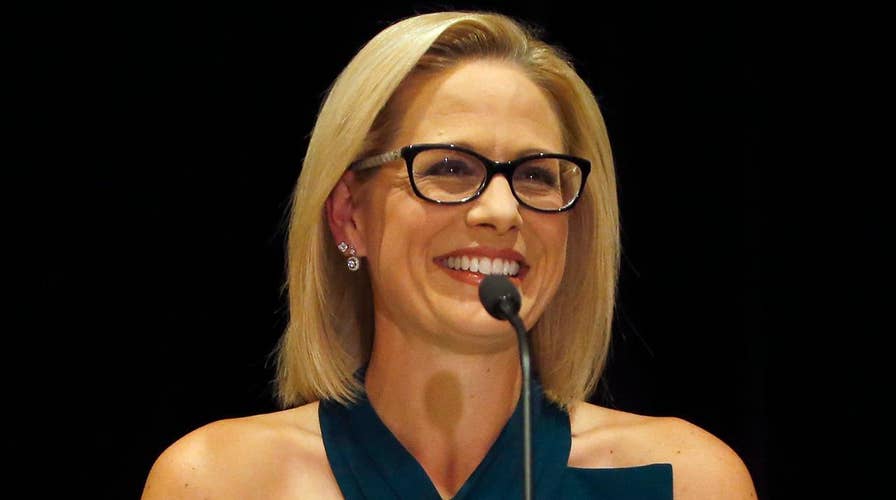Sinema turns historically red seat blue in Arizona
Republican Rep. Martha McSally concedes Arizona's Senate race to Democratic Rep. Kyrsten Sinema; Alicia Acuna reports from Phoenix.
Rep. Kyrsten Sinema, D-Ariz., was declared the apparent winner this week in her midterm election race for the U.S. Senate, becoming the first woman to represent her state in the Senate and the first Democrat elected to represent Arizona in the Senate in 24 years. She is also the first person in the nation ever elected to the Senate who has come out as bisexual.
Sinema narrowly defeated Rep. Martha McSally, R-Ariz., to take the Senate seat now held by Republican Jeff Flake, who did not seek re-election.
So was this Democratic victory in Arizona just a matter of luck? Is Arizona now a purple state? What did Sinema do in Arizona that Democratic Senate candidate Rep. Beto O’Rourke couldn’t do in Texas, when he was defeated by GOP Sen. Ted Cruz by a narrow margin?
And the biggest question of all: What can Democrats around the nation learn from Sinema’s victory that will help them recapture the White House, hold onto their new majority in the House, and become the majority party in the Senate in the 2020 elections?
There are several factors contributing to Sinema’s victory in Arizona that Democrats should consider when selecting presidential and vice presidential candidates, as well as congressional candidates in two years.
These include:
Moderation
Sinema ran as a centrist and spoke during her campaign of finding “common ground.” She used the phrase again in her victory speech and even House Minority Leader Nancy Pelosi, D-Calif., spoke of it after the Democrats won the House.
This idea of finding common ground can be especially helpful for Democrats in states that candidate Donald Trump carried in 2016. It signals a more moderate tone in red states and can appeal to crossover voters, as we saw with Sinema in Arizona.
Sinema won among Democratic voters in areas like Maricopa County, which included Phoenix. But she also won over independents and even won Pima County, the area McSally represents in the House.
The willingness to work with politicians from the other side of the aisle obviously appeals to voters – especially when voters are tired of a do-nothing Congress.
Running women candidates
Both Sinema and McSally are women. Across the nation a record number of women ran and a record number of women were elected to Congress – a clear indication that many voters are looking favorably on female candidates.
But the midterm elections were about more than the women who are ran for office – they were about women who ran away from the Republican Party and, it would seem, from President Trump – his rhetoric and both his and his administration’s attitudes toward women.
We are seeing a shift, and not just in Arizona, of more women moving toward the Democratic Party – particularly white women, who have been becoming more Democratic since 2012. Republicans have lost the 14 percent lead over Democrats among women they held six years ago.
And women candidates speak to more issues that voters seem to care about – like health care, education, climate change and the minimum wage.
A growing Hispanic population
Arizona is certainly looking more purple – and not just because it is sending the first woman and first Democrat since 1995 to the Senate. The growing Hispanic population of Arizona is over 2 million. Almost a third (31 percent) of the state’s population is Hispanic.
And this growing Hispanic population is part of a national trend. According to U.S. News & World Report, in 2000 10 states had a Hispanic population of at least 10 percent. But by 2017, 22 states were at least 10 percent Hispanic. The states with the largest Hispanic populations are New Mexico (49 percent), Texas (39 percent) and California (39 percent).
Although Hispanics typically vote for Democrats, getting this population out to vote has been a challenge for both parties. But as more and more Hispanics turn out to vote, Democrats can be expected to gain votes.
So what can the Democrats learn from the senatorial race in Arizona for 2020? Find common ground to appeal to moderate crossover voters; find a way to get more Hispanics out to vote; and give female candidates serious consideration for the presidential nomination or – if a man is nominated – select a woman as his vice presidential candidate.

